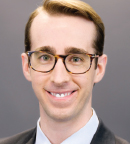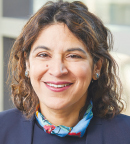
Timothy D. Murtha, MD, MHS

Nita Ahuja, MD, MBA
I received a coffee mug from a physician colleague some years ago with the tag line: “Please do not confuse your Google search with my Medical Degree.” Physicians of all stripes and colors can relate to the agony of debunking a “Dr. Google” diagnosis. However, in a fast-evolving health-care landscape, where advances in medical technologies are coinciding with the digital revolution, we would be negligent if we did not reexamine our medical education and training programs. The next generation of doctors must be prepared to leverage machine learning and interpret direct-to-consumer genetic testing, with as much confidence as they would with a stethoscope and TNM staging.
Each advance has come with its own unique challenges. The rise of technology has led to an increased focus on documentation and clerical work. The expansion in the amount of health data at our fingertips has increased a physician’s required skill set exponentially—potentially contributing to the rising rate of physician burnout. Today’s physicians are simply not optimally prepared for today’s health-care environment. In fact, the current didactic curriculum in most medical schools would likely be familiar to the students who sat in Osler’s lecture hall at Johns Hopkins Hospital, some 100-plus years ago.
Times have changed, and a 21st-century revision of our medical training programs for students, residents, fellows—even seasoned physicians—is needed. As a profession, we need to transition from a reactionary, disease-based mindset into one focused on healthy longevity. Instead of rote memorization, we need to advance in the realm of data translation. And perhaps most important, we need to rediscover the importance and therapeutic value of the doctor-patient relationship.
Healthy Longevity
“Antiaging” gets a bad rap. However, parse out the snake oil and wrinkle creams, and antiaging medicine, as a principle, presents a necessary and radical shift in the way medicine is taught: the notion that aging does not necessarily bring a degradation in quality of life. For physicians, this is a radical concept. We are taught to react to symptoms after they emerge, not to prevent them years and decades in advance. “You’re getting old” is not a clinical explanation the patient will be willing to accept.
Quality of life means more than just the number of stairs a person can climb. Health-care professionals need to internalize the fact that the most important part of our patients’ lives cannot be captured in their electronic medical records. Spirituality, for example, can be a powerful force in both healing and in disease palliation. Although sometimes considered taboo, religious beliefs are often elemental components of a patient’s worldview and can be important in determining appropriate end-of-life care. In addition to the practical aspects of cultural logic, inviting patients to share their values and motivations simply makes the work of being a doctor more enjoyable. Asking about one’s bucket list can open a window into their outside lives. It humanizes patients and can transform room 7214 with cholangiocarcinoma into a mother who simply wants to hear her daughter play the violin in the spring recital.
As patient objectives and goals differ depending on the individual, the value of a treatment is relative. Although one patient may want to maximize survival, others may be more interested in preserving quality of life. As such, trainees must learn to weigh therapeutic modalities in the context of the person as a whole. Chung and Carlson presented oncologists and patients with breast cancer with a series of clinical vignettes and potential treatment options.1 Answers varied by individual characteristics—younger patients were willing to assume more toxicity for small increases in survival—but they also found that provider and patient objectives were not always aligned. If a patient’s goals for treatment do not match those of the physician, the gold-standard therapy may not be the best medicine for that individual. Medical education, especially in relation to oncology, may benefit from an increased focus on quality of life years, as opposed to simply separating the lines of Kaplan-Meier survival curves.
Teaching physicians to rethink the definition of “healthy” has a significant impact on how we approach research and innovation. And there is a lot of low-hanging fruit. For example, physicians should be taught how to personalize preventive care for the teenager with a family history of colorectal cancer, not just how to treat the young patient. Or what about basic body composition markers? For years, health authorities have explained body mass index as an unfit measure of health individual level—and yet it is the standard we teach our physicians to assess risk of chronic disease.2 Physicians should be taught to extend their patients’ health span, not just life span. Healthy longevity should be a physician’s north star and must act as a central component in the process of restructuring medical education.
Data Translation
The big data era has reshaped medicine so that the available information has far surpassed the capacity for an individual to master medicine in a lifetime. The volume of precision health data to collect on an individual patient could keep one physician elbow deep in an n-of-1 trial for a lifetime. Not to mention cost and quality data—so vast that they are considered entirely independent of a medical organization’s clinical arm. The question “How much will this cost?” is usually unanswerable. In addition to the monetary costs, patients are usually uninformed about all the potential unmeasurable expenses that should be central to the process of determining the overall value of an intervention, such as time, emotional distress, pain, and opportunity costs.
And yet, all of these data are meaningless unless we can extract value from them. Translating data—be it genetic test findings or relative value unit trends—is a skill that physicians must master. The Precision Medicine Initiative was announced by the White House in 2015 with the goal of improving the understanding of disease based on individual genetic and phenotypic characteristics. Since then, consumer genomics has boomed into a billion-dollar industry. The National Institutes of Health All of Us research program aims to gather data from one million individuals to understand health and disease. Amazon, JP Morgan, and Berkshire Hathaway are all in pursuit of the next disruptive technology in health care that can scale the approach to the masses.
The next generation of doctors must be prepared to leverage machine learning and interpret direct-to-consumer genetic testing, with as much confidence as they would with a stethoscope and TNM staging.— Timothy D. Murtha, MD, MHS, and Nita Ahuja, MD, MBA
Tweet this quote
Missing from the conversation, perhaps, are the physicians on the front lines. After all, physicians are the ones who will bridge the gap between emerging technology and the patient population. And although major academic centers and the corporate world celebrate the rise of genomics and the rise of the self-quantified self, many community doctors are still using fax machines and struggling to transition to electronic health records.
In fact, despite the undeniable importance of precision medicine, one study reported that only 6% of current medical students feel appropriately trained to use genomic data in their clinical care.3 Regardless of their preferred specialty, medical training will need to teach doctors to integrate and interpret complex omics data in the context of numerous variables that influence expression with the managerial acumen necessary to run a business. Clinical care, cost, and quality are intrinsically linked. Translating these data into actionable guidance is incredibly difficult; the textbook doesn’t exist—yet.
Interpersonal Relations
Patients are people, not papers. Where current medical training teaches physicians to read numbers and assess symptoms, our programs fail to teach basic people skills that influence the patient-doctor interaction. Cultural norms, lifestyle, personal and family histories, environment—all have an impact on how a patient, and a physician, presents and reacts to information. The white coat, for example, can evoke fear and memories of personal tragedy for some, whereas others are reminded of the comfort and compassion of their family physician. In some Asian cultures, health-care decisions are expected to be a family discussion, with priority placed not on the individual, but on the unit.
Medical students and trainees should be given a framework for how to listen and relate to their patients. The ability to listen and “read the tea leaves” will become increasingly important with the rise of telemedicine and app-based care. There is a story beyond the laboratory work, and elucidating that human element is a skill that can be taught.
Medical training would do well to take the lead from business schools, who have understood for decades the importance of effective communication. In negotiations, management, and leadership initiatives, clear communication serves as the bedrock in the process of successfully turning an idea into an action. Often, disappointments and frustrations on behalf of patients and their family members are due more to a failure to set appropriate expectations than to objective results. Employment of the teach-back method, in which patients are asked to tell the provider what they heard, often uncovers discrepancies between the message the provider intended and what patients understood. With the welcome increased emphasis on patient autonomy, effective communication is more important now than ever before. If patients are not able to understand their disease and therapeutic options, what chance do they have of making the best choice?
A Fundamental Responsibility
With the world’s medical intelligence available on our mobile phones, the role of the physician is changing. By definition, stemming from the Latin docere, which means “to teach,” the doctor is a steward of medical knowledge—a trusted advisor. The role of today’s physician is that of a quarterback, responsible for guiding a patient, strategically, through a noisy labyrinth of information and obstacles. In some ways, as technology takes over many clerical duties and data processing, we are coming back to our teacher roots. Data alone cannot make anyone healthy. It’s the clinical interpretation and Spidey-sense of the old-fashioned doctor, made scalable by technology, that will transform the health system. Training physicians across the career trajectory to leverage actionable precision medicine, promote healthy longevity, and foster interpersonal skills is not just a good idea—it is our responsibility, fundamental to the patient-doctor compact. Or else, I’ll need to retire my Google mug—and my medical degree—as a bad joke. ■
Dr. Murtha practices in the Yale Department of Surgery, Yale School of Medicine. Dr. Ahuja is the William H. Carmalt Professor of Surgery and Chair of Department of Surgery, Yale School of Medicine.
Disclaimer: This commentary represents the views of the author and may not necessarily reflect the views of ASCO or The ASCO Post.
DISCLOSURE: Dr. Murtha reported no conflicts of interest. Dr. Ahuja has received grant funding from Cepheid and Astex, has served as consultant to Ethicon, and has licensed methylation biomarkers to Cepheid.
REFERENCES
1. Chung CT, Carlson RW: Goals and objectives in the management of metastatic breast cancer. Oncologist 8:514-520, 2003.
2. Obesity: Preventing and managing the global epidemic. Report of a WHO consultation. World Health Organ Tech Rep Ser 894:1-253, 2000.
3. Eden C, Johnson KW, Gottesman O, et al: Medical student preparedness for an era of personalized medicine: Findings from one US medical school. Per Med 13:129-141, 2016.

